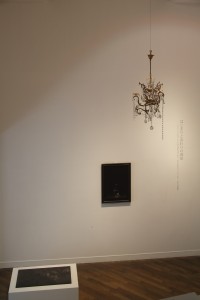
NIPPON CAMERA
Magazine
Nippon Camera Co., Ltd.
NIPPON CAMERA
October Issue / p. 171
September 20, 2018
A couple of things about photography
No.58
Anxiety and freedom release the body from seeing and open the door to questioning.
Publisher: Nippon Camera Co., Ltd. / Writer: Ryoko Kiritani
The introduction to Mami Kosemura: Phantasies Over Time (* The Japanese title is “Gen-ga (Phantom Painting) -The Epidermis of Images, Hara Museum of Contemporary Art, 2018) , Gallery I, titled “Room of Beginnings and Endings: Drawings and the beginning or end of various works (initial impetus or debris)”, was enigmatic.
In addition to photographic prints, the room was filled with a stone slate, books, a chandelier, candelabras, binoculars, trays, and other ambiguous objects. These objects fit so well into the Hara museum, which was built as a private residence of western-style and renovated to a museum, so that it was difficult to even discern the extent of the exhibits.
Therefore, the viewer had to bend down and look up, referring to the commentary sheet, to carefully appreciate every corner of the room. The act of exploring a Western-style house was like a fantasy role-playing game.
This initial experience made the viewer aware of his or her own movements. For example, when looking at a series of photographs in the next Gallery II, the viewers went back and forth. When looking at a painting-like stop-motion, they stood still for a long while. So what about looking at a print of thousands of photos processed like a painting? The viewer's body was at a loss whether they should move or stop.
The exhibition progressed through Galleries III, IV, and V, using a variety of approaches to create moving and stationary images. Each work was created in a complex process, but it was not difficult to understand at all, as the content of the work itself and its captions revealed the process. However, the fact that nothing was hidden from viewers made them feel uneasy inversely. So what was it that we were seeing now?
When I returned to Gallery I, it seemed as if all the answers were already there. I realized that the mystery was not a mystery, but the question was also the answer. To begin with, the title of this exhibition, Gen-ga (Phantom Painting) -The Epidermis of Images, clearly indicates a group of pieces that can only be called such. I thought this was because my body had been changed by experiencing a journey like a role-playing game.
「小瀬村真美:幻画~像(イメージ)の表皮」の導入、「はじまりとおわりの部屋~ドローイングワークと各作品のはじまり、またはおわり(きっかけ、または残骸)」と題された、ギャラリーⅠの展示は謎めいていた。
プリントがあるだけではなく、石板、本、シャンデリア、燭台、双眼鏡、トレー、そして何であるか判然としないオブジェなどが置かれた展示は、私邸として建造された洋館を改装した原美術館に調和し、どこまでが展示物なのかも判別し難かった。
それゆえ、見る者は解説シートを参照しながら、時に屈み込み、時に見上げ、部屋の隅々まで丁寧に鑑賞することになる。洋館を探索するように鑑賞する行為は、ファンタジーのロールプレイングゲームのようでもあった。
初めにこの経験をすることで、見る者は、自らの動きを意識するようになる。例えば、ギャラリーⅡの、連続写真を見る時は、行きつ戻りつする。コマ撮りの写真アニメーション、絵画的ストップモーションを見る時は、じっと立ち止まる。それでは、数千枚の写真を絵画のように加工したプリントを見る場合はどうか。見る者の身体は、動くべきか、止まるべきか、戸惑う。
さまざまなアプローチで、動く像と止まる像を浮かび上がらせながら、ギャラリーⅢ、Ⅳ、Ⅴと展示は展開してゆく。それぞれの作品は、複雑な過程によって制作されているが、その過程は作品そのものや、キャプションなどによって明かされているので、決して難解なわけではない。だが、何も隠されてはいないという、そのことが逆に、見る者の身体を不安にさせる。いったい、この身体を動かしている、今見ている者は何なのだろうかと。
ギャラリーⅠに戻ると、そこには、すでにすべての答えがあったようにも感じられた。謎は謎ではなく、問いはまた答えでもあったのだ。そもそも「幻画~像(イメージ)の表皮」というタイトルが、そうとしか呼びようのない作品を明確に示している。このように思えたのは、ロールプレイングゲームのような旅を経験した、他ならぬこの身体が変化したからなのだろう。
(記事より抜粋)